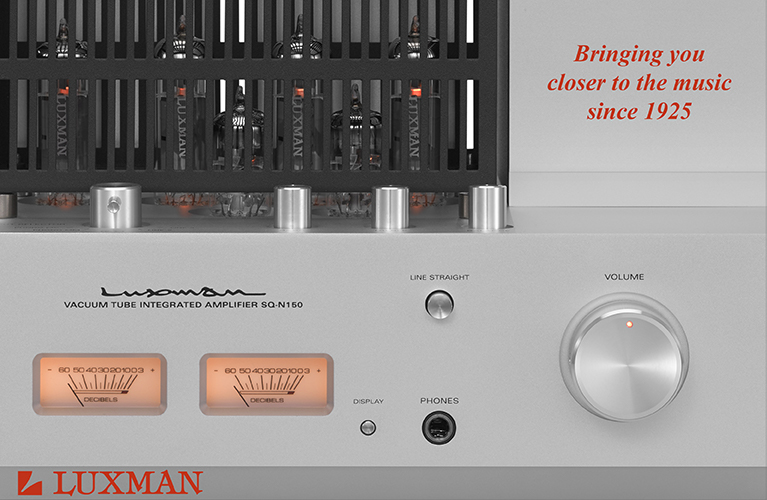In 2011, Doug Schneider, founder of the SoundStage! Network, reviewed the Simaudio Moon 350P preamplifier and found it to be a lot of performer for the money, mostly due to its neutrality and high transparency. Since then, the preamp has been redesigned and relaunched as the Moon Neo 350P ($3700 USD). It’s Simaudio’s lowest-priced preamplifier, and the only preamp in the Neo line; above it are the Moon Evolution 740P ($9500) and 850P ($30,000). In the photos accompanying Doug’s review, the Moon 350P had a pedestrian, almost industrial look that Doug called “unassuming and rather basic.” By contrast, the Moon Neo 350P is a sexy beast. But how does it sound?
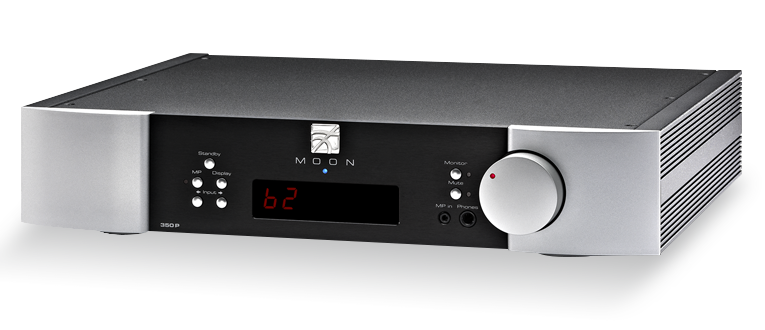
Description
The Moon Neo 350P is an audio component -- so even if it’s better looking than the Moon 350P, it’s still a rectangular metal box measuring 16.9”W x 3.5”H (including feet) x 13.1”D and weighing 16.5 pounds. However, it’s now a very attractive rectangular metal box, with beautifully curved front-panel “cheeks,” as Simaudio calls them, flanking the thick central control and display panel. The side panels are nearly 3/4” thick and have deep grooves running front to rear -- a subtly attractive touch. The fit and finish of the heavy-gauge panels of my black-and-dark-gray sample were excellent. The other special-order color options are silver and the one I found most attractive, two-tone: a mix of black and silver. The aesthetic touches continue underneath, to the silver-accented feet. In each of the finishes, the styling of the curved front panel and controls, and the attractive overall design, make the Moon Neo 350P a beauty to behold and pleasant to the touch.
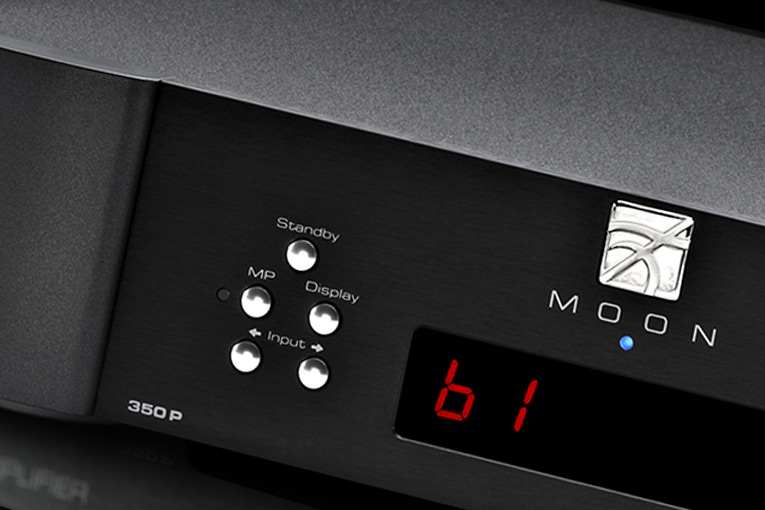
To the left of the display is an array of five pushbuttons: Standby, MP (media player), Display, and Input. To the right of the display are a 1/8” minijack for the MP input, which I found works as expected; however, while this input would be handy for allowing a friend to play sample tracks, or for playing music from a streaming service via smartphone, the rear-panel inputs are what will be used for most serious listening. Next to the MP input is a 1/4” headphone jack, and above these jacks are pushbuttons labeled Monitor and Mute. Plugging in headphones doesn’t mute the rear outputs, but the Mute button mutes all outputs -- to avoid reinforcement from your speakers when using headphones, make sure your power amplifier is turned off.
Rather than use a simple disc for the volume control, Simaudio designed theirs with a subtly curved depression where the fingers grasp it. This small touch made it feel as if the dial had been customized to fit my hand. The level indicator on the volume knob and the large-lettered display screen are red LEDs easily readable from across the room. I found myself often neglecting the remote-control handset and taking the time to use the front-panel controls, for their highly satisfying tactile feel and mechanical feedback. Nor is Simaudio’s multi-device remote impressive -- it duplicates all of the Neo 350P’s front-panel controls, but has a generic feel and a plasticky look.
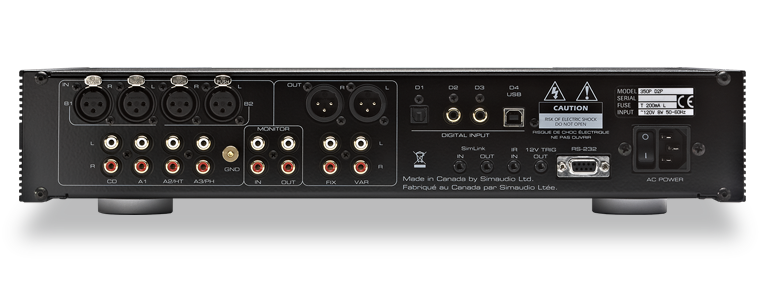
On the rear panel are four pairs of single-ended and two pairs of balanced inputs. The volume control affects the balanced outputs and the pair of single-ended outputs labeled Var (for Variable), but for the second pair of single-ended outputs, labeled Fix (Fixed), the 350P routes a line-level signal to a recording device. Further flexibility is provided by the single-ended input labeled A2/HT; this can be configured to bypass the gain section, for use with a home-theater processor. There are also pairs of single-ended inputs and outputs labeled Monitor; when activated by pressing the Monitor button, these bypass the volume control and form a loop to connect the output to an external component such as a processor or recording device, then back into the preamp if required. Also on the rear panel are an IEC-compatible power-cord inlet, a main On/Off switch, an RS-232 port, an IR trigger input, and a SimLink input and output pair (to permit the Neo 350P to be connected to and communicate with other Simaudio products). Simaudio says that, for best performance, the Moon Neo 350P should be left powered up at all times.
In addition to the standard features included in my review sample, Simaudio also builds the Moon Neo 350P with optional DAC and phono-stage boards. If ordered with the Neo 350P, both boards together cost $1000. Or they can be bought later for aftermarket installation, for $900 (DAC) and $400 (phono).
The DAC board is Simaudio’s newest, D3 version, with four digital inputs: optical, USB, and two coaxial. The D3 DAC accepts PCM signals with word lengths of 16 to 32 bits (32 bits via USB only), and frequencies of 44.1 to 384kHz (352.8 and 384kHz via USB only). Decoding of DSD64/128/256 is supported only via USB. When the DAC board is installed, the digital inputs are at the upper middle of the rear panel.
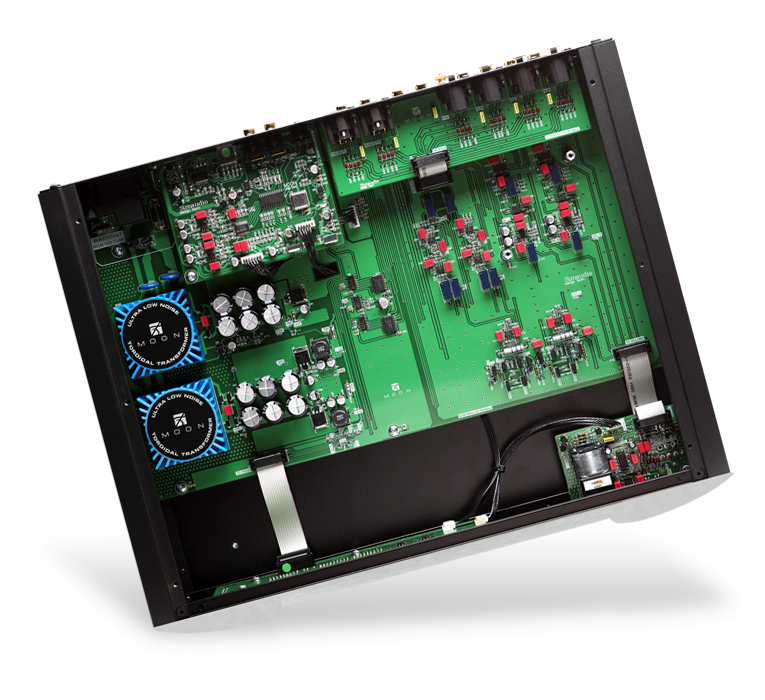
The phono section supports moving-magnet and moving-coil cartridges, and offers adjustment of the resistance, capacitance, and gain settings. The phono-circuit input replaces the pair of single-ended analog inputs labeled A3/PH, which are accompanied by a connection for the phono ground wire.
Simaudio claims that the updates of the Moon 350P’s electronics to Moon Neo 350P status include an improved gain circuit, a more efficient circuit layout, and higher qualities of various parts. The company says that the Neo 350P has a “symmetrical circuit design” that provides 6dB of gain, and “an oversized power supply using two toroidal transformers in conjunction with three stages of DC voltage regulation.” The total harmonic distortion from 20Hz to 20kHz is specified as 0.0005%, as is the intermodulation distortion -- in other words, very low. The Neo 350P’s signal/noise ratio at full output is a claimed 120dB. Simaudio’s confidence in this and in all its models is evident in the ten-year warranty the company offers (with registration), as well as the 35 years Simaudio has been in the business.
Setup
I used iTunes to play music files stored on my iMac, which was connected to my Benchmark Media Systems HGC2 DAC via a long Monoprice USB cable. Simaudio suggests using the Neo 350P’s balanced connections because they “provide you with an even better signal-to-noise ratio.” With that advice in mind, I connected the Benchmark to the Neo 350P and the Neo 350P to the power amplifier with Dynamique Shadow balanced interconnects (XLR). The power amps were mainly my Audio Research D300 and, periodically, Simaudio’s Moon Neo 330A (review forthcoming), driving Paradigm Reference Prestige 95F speakers via Transparent Music Wave Ultra speaker cables. NAD’s Viso HP50 headphones were plugged directly into the Neo 350P’s 1/4” headphone jack. I did briefly test the DAC-to-preamp and preamp-to-power-amp connections with single-ended cables, but heard little difference in sound; following Simaudio’s suggestion, I did most of my listening in balanced mode.
Listening
To hear how well an audio component can handle extremes of high and low frequencies, I like to use electronic music. Composers of electronica tend to use copious amounts of strong, deep bass and brilliant highs. I played a mix of Swedish House Mafia’s “Don’t You Worry Child,” from their 2012 compilation Until Now (16-bit/44.1kHz AIFF, Astralwerks). It begins with melancholy singing -- the system easily reproduced this voice, with the expected emotion intact. As the singing grows stronger and more uplifted, the track builds to a big, complex, extravagant arrangement of pulsing bass, floating ethereal melodies, and wildly processed voices. The sound goes from simple to complex and back again, and the Neo 350P nailed it at both ends of the audioband. The deep bass of the more complex section of this track was tightly presented, the transients of low-frequency sounds all being clear, distinct, and with appropriate slam -- there was none of the sensation of blurred bass or bloated low tones that are often produced by more modestly priced preamps. This high level of refinement was also audible at the top end of the audioband: the high-pitched sounds that are fairly forward in this recording remained forward and were clearly articulated, without becoming bright or drawing undue attention to themselves. The Neo 350P’s sound also seemed unemphasized across the audioband -- an evenhandedness that allowed this track, and others like it, to shine as full compositions rather than being bass- or treble-heavy affairs, which they often sound like through inferior gear.
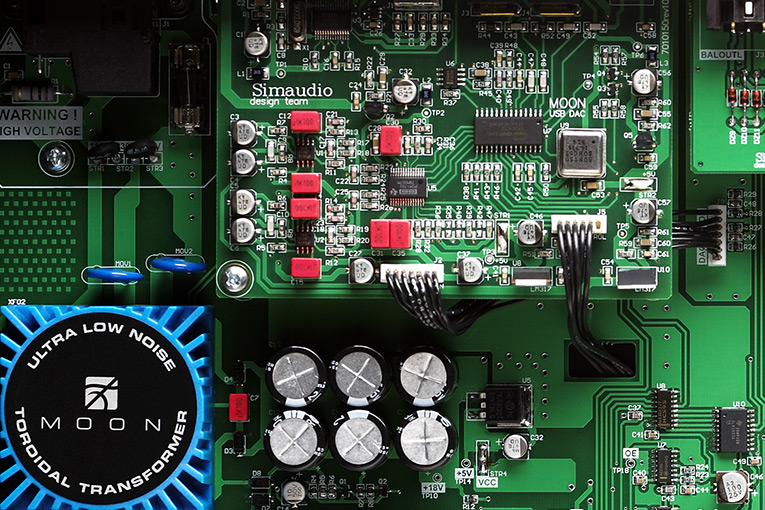
I followed the fully electronic selection with a dynamic acoustic one by sending the Moon Neo 350P Purcell’s Chacony for Strings in G Minor, performed by the Orpheus Chamber Orchestra (16/44.1 AIFF, Deutsche Grammophon). The preamplifier reproduced the ensemble with tremendous refinement. The soundstage was broad, extending beyond the physical boundaries of my Paradigm Prestige 95Fs, and providing suitable aural space for all of the musicians -- nothing felt cramped. There was also a good sense of depth, which provided sufficient dimensionality to the aural images of instruments, and made it easy for me to envision actual performers arrayed on a stage. Through the Neo 350P, the Orpheus neither sounded lost in a huge space nor jammed together in a practice room. The Neo 350P easily projected the power of a group of violins playing together, allowing them to have a strong, appropriately forward sound when that was called for, without drowning out the instruments playing in more quiet support. It also laid out the notes from the lower strings as a firm base for the melodies, while remaining detailed and firmly controlled. As with the electronic bass sounds mentioned above, there was a wonderful clarity in the sound of the lower instruments -- rather than blending into their neighbors, each was distinctly imaged.
Wanting to play something for full orchestra, to further test the Neo 350P’s high-frequency resolution, I chose a 1994 recording of Janáček’s Sinfonietta, as performed by Václav Neumann and the Czech Philharmonic (16/44.1 AIFF, Supraphon). The first movement, Fanfares, contains a strenuous workout for the brass -- they tackle both the melody and most of the background support. It was easy to pinpoint individual performers in space, from left to center to right. The dynamic range of the brass was clearly displayed, the transition from piano to fortissimo easily discernible. There was a trace of glare in the trumpets in the loudest transients, but otherwise, the sound was neutral -- no part of the audioband was recessed or emphasized -- and the strident melodies were accurately more forward than the underpinning harmonies without overwhelming them. But this slight glare was easily overshadowed by the 350P’s total accuracy in all other areas.
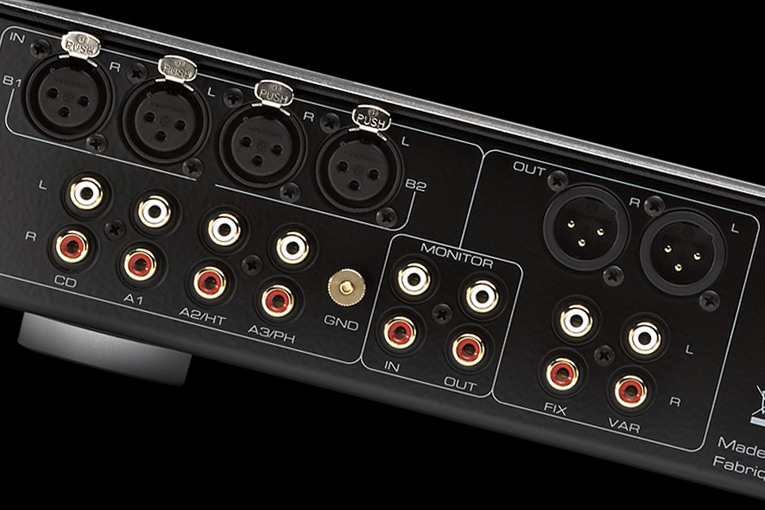
Later in the Sinfonietta, accents of very high pitch on piccolos and flutes never sounded shrill or overemphasized, which often accompanies brass glare in playback. Again, I found the imaging to be fabulous, as the work transitioned into passages for full orchestra and the players were spread out over a soundstage of convincing width and depth.
Changing genres again, I picked “Flash Light” from Pure Funk, a 1998 Parliament compilation (16/44.1 AIFF, PolyGram). This engaging toe-tapper was first released in 1977, and is typical of the band’s flamboyant funk style. The recording has almost no depth, but it was useful in determining the Neo 350P’s general sound, which I found neutral overall -- again, no part of the audioband was emphasized or recessed. Consequently, the sound felt neither forward, pushing specific instruments into my lap, nor did it sound laid-back, distant, or relaxed. This preamplifier allowed the music to be exactly what I felt was in the recording. The processed-sounding voices, guitars, bass, and keyboards all had that feeling of instruments and performers spread out along a horizontal line at about ear height that I find typical of recordings made in the 1970s and ’80s. There was little feeling of height or depth, as I’d expected, but the Neo 350P’s general sound quality gave me enough confidence to say that the limited sensation of space I heard was no more and no less than what this recording contained.
Maroon 5’s “Come Away to the Water” appears on The Hunger Games: Songs from District 12 and Beyond (16/44.1 AIFF, Republic), a collection of soundtrack extras released in 2012. While distinguishing single male from single female voices is normally easy to do, in this song the words are often sung by multiple singers singing the same note or in very close harmony. I was surprised by how easy it was to differentiate the two singers -- the last time I’d played this album was with Rotel’s modestly priced RC-1570 preamplifier-DAC ($999) and RB-1582 Mk.II power amp ($1599). At that time, I’d thought I was hearing just a single voice. The larger drums in this track were rendered clearly and accurately enough that I could almost see the vibrations moving across the drum heads. This ability to easily envision real musicians playing was something I quickly found satisfying with each good recording I played. Further listening to the Hunger Games album, with its many well-recorded male and female singers and acoustic instruments, strengthened my growing conviction that the Moon Neo 350P faithfully reproduced everything on each recording.
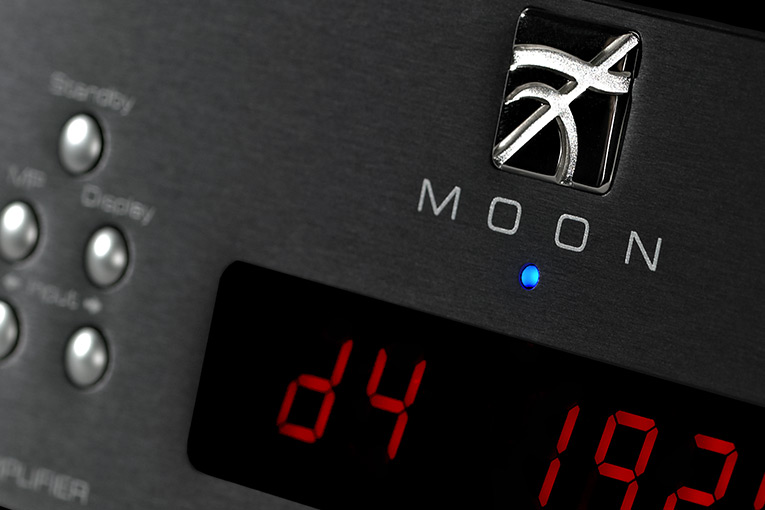
The more music I played, the less I expected to hear flaws in the Neo 350P’s highly neutral yet incisive and detailed sound. I kept coming back to the well-worn notion of the ideal preamp: a straight wire with gain. I know that the circuits inside the Neo 350P are actually complex -- but its sound approached that simply expressed ideal.
Listening with headphones
To assess the Moon Neo 350P’s discrete headphone amplifier, I plugged my NAD Viso HP50 ’phones into the Simaudio’s jack, shut off my power amp, and played Swedish House Mafia’s “Don’t You Worry Child.”
A strange thing happened -- the heavily processed voices seemed at times attenuated, and at others nearly absent. Additionally, this recording’s deep bass and substantial highs lost all of their impact, although the midrange remained clear and accurately rendered.
Maroon 5’s “Come Away to the Water” sounded vastly better, with neutrally reproduced voices and reasonably accurate imaging, but the differences between the male and female singers weren’t as clear as they’d been through my speakers. The supporting instrumental music, most of it in the midrange, sounded unemphasized and fairly clear. The Neo 350P’s laid-back midrange gave most music a relaxed feel. The orchestra in Janáček’s Sinfonietta felt somewhat distant, and attenuated at low and high frequencies.
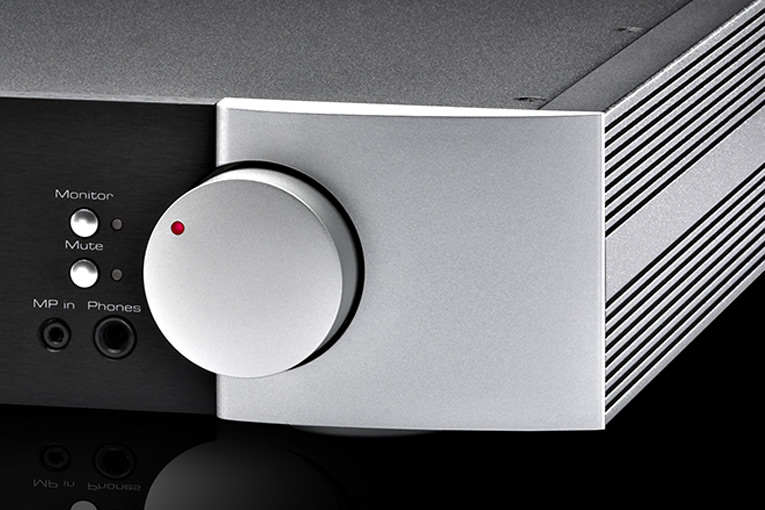
With headphones, soundstaging has always been hard for me -- the music sounds artificial when laid out along an imaginary line drawn between the centers of my ears. That said, most of what I listened to through headphones driven by the Neo 350P had good distribution across space, with images that didn’t collapse into the center of my head -- or pan everything to hard left and hard right.
The best sound I got with headphones and the Neo 350P was from the recording of Purcell’s Chacony, which had a good balance of the delicate sound of the harpsichord and the grouped strings. No instrument dominated inappropriately, and none of the background performers actually disappeared into the background. The grouped strings were clearly presented, but with no sharpness of sound. That said, the performance felt rolled off at the lower and higher frequencies.
For headphone part-timers like me, the Neo 350P provided acceptable performance; for serious headphone listening, a dedicated headphone amp would certainly be better -- and Simaudio makes some.
Comparison
I did some back-to-back testing to help judge the sonic impact the Neo 350P had on the sound of my system when compared to my reference preamplifier, Hegel Music Systems’ P20 ($2900), which is designed in Norway. I also compared that experience to my notes and recollections of the recently reviewed Rogue Audio RP-5 ($3500), a tubed preamplifier made in my area of eastern Pennsylvania, here in the US. I consider both of these models to be high-quality performers in this busy price region.
The Simaudio and Hegel sounded similar -- each had notably neutral and transparent sound. As a result, the comparison of the Canadian and Norwegian models requires a discussion of nuances. Although I consider both neutral, the Hegel has an ever-so-slightly forward character. I found that each projected a broad, deep soundstage of similar size and provided accurate spatial images. No winner there.
Where the two most differed was in their ultimate clarity -- the empty space in the soundstage was more clearly empty through the Neo 350P. The distinct presentation of sounds was also slightly clearer with the Simaudio. All transients, throughout the audioband, were subtly more accurate with the Neo 350P -- it sounded more incisive than the P20. In contrast, the Hegel P20 presented sound transitions that were very slightly less precise, but left me with the feeling of sounding more lifelike because they felt more relaxed. It was like the difference between a great recording played on both a great high-resolution digital system and a great turntable system. Both will sound excellent, but the digital version will sound razor-sharp and precise, like the Simaudio, whereas the Hegel has a bit of ease. I own the Hegel, but my time with the Neo 350P has made me think about whether or not I should consider making a change.
I found the Rogue RP-5’s midrange performance alluring, due to its subtle midrange accentuation and warmth -- probably due to the vacuum tubes in its circuitry. Interestingly, that added warmth in the ever-important midrange was the only area where the Rogue felt like a tubed device -- otherwise, I heard none of the rolled-off highs that can happen with tubes. However, the Rogue had a thinner, less accurate feeling when reproducing extremely low frequencies, and not nearly enough slam for my taste -- the Moon Neo 350P’s bass was far more visceral. Nor did the feeling of tube-like warmth extend into the highs or lows. By contrast, the Neo 350P displayed all of the source signal clearly, and without coloration. That neutrality of sound made the Neo 350P more revealing of vocal recordings than the RP-5, even with the Simaudio’s mild midrange emphasis. Differences existed in the soundstage as well, though these were subtler; the RP-5’s stage felt narrower and shallower than the Neo 350P’s, but still accurate within its reduced scope. The Simaudio’s sound was ultimately more precise than the RP-5’s across the audioband, and more convincing in its reproduction of space. If I had to choose between them, I’d buy the Moon Neo 350P.
Conclusion
Simaudio has given the Moon Neo 350P preamplifier a visual beauty that was not part of the original Moon 350P. The qualities of manufacture, visual appearance, and tactile feel of my review sample were all excellent. That same excellence extended to its formidable sound -- the Neo 350P had a neutral transparency that presented each recording played through it without embellishment. I never felt that it was holding back the music because of its own limitations -- it let all details flow through. The width and depth of its soundstage were excellent. The Simaudio Moon Neo 350P’s sound, connectivity options, and ten-year warranty make it difficult to find another preamplifier in its price range that is as easy to recommend.
. . . Erich Wetzel
erichw@soundstagenetwork.com
Associated Equipment
- Speakers -- Paradigm Reference Prestige 95F
- Headphones -- Bowers & Wilkins C5, NAD Viso HP50
- Preamplifier -- Hegel Music Systems P20
- Amplifiers -- Audio Research D300, Simaudio Moon Neo 330A
- Source -- Apple iMac running iTunes
- Digital-to-analog converter -- Benchmark Media Systems DAC2 HGC
- Speaker cables -- Transparent MusicWave Ultra
- Interconnects -- Audio Quest King Cobra (XLR) and Ruby (RCA), Dynamique Shadow XLR, Transparent MusicLink Super (RCA), Monoprice USB digital, generic optical (TosLink)
Moon by Simaudio Neo 350P Preamplifier
Price: $3700 USD (optional DAC and phono stage, $1000 when bought with new base unit).
Warranty: One year parts and labor (ten years with product registration).
Simaudio Ltd.
1345 Newton Road
Boucherville, Quebec J4B 5H2
Canada
Phone: (450) 449-2212
Website: www.simaudio.com






















